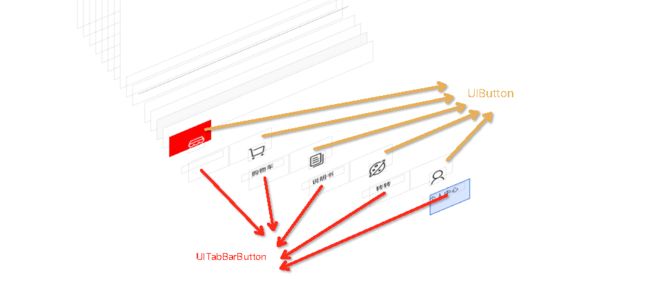日常开发中的系统自带的tabbar基本可以满足需求,但有时也需要特殊的tabbar来展示。
一.自定义单个的tabbarItem
1.创建 LeeBaseTabBarViewController : UITabBarController
tabbar的样式设计{
}
- (void)viewDidLoad {
[super viewDidLoad];
[self addChildViewControllerWithClassname:[HomeViewController description] imagename:@"icon_tab_home_default" title:@"首页"];
[self addChildViewControllerWithClassname:[PersonalViewController description] imagename:@"icon_tab_personal_default" title:@"个人"];
//使用自定义的tabbar来替换
LeeTabBar *tabBar = [[LeeTabBar alloc]init];
[self setValue:tabBar forKeyPath:@"tabBar"];
}
// 根据需求添加相应的子控制器
- (void)addChildViewControllerWithClassname:(NSString *)classname
imagename:(NSString *)imagename
title:(NSString *)title {
UIViewController *vc = [[NSClassFromString(classname) alloc] init];
LeeBaseNavigationViewController *nav = [[LeeBaseNavigationViewController alloc] initWithRootViewController:vc];
nav.tabBarItem.title = title;
nav.tabBarItem.image = [UIImage imageNamed:imagename];
nav.tabBarItem.selectedImage = [[UIImage imageNamed:[imagename stringByReplacingOccurrencesOfString:@"default" withString:@"selected"]] imageWithRenderingMode:UIImageRenderingModeAlwaysOriginal];
[self addChildViewController:nav];
}
2.创建LeeTabBar : UITabBar
@interface LeeTabBar ()
@property (nonatomic, weak) UIButton *middleBtn;
@end
@implementation LeeTabBar
- (instancetype)initWithFrame:(CGRect)frame {
self = [super initWithFrame:frame];
if (self) {
UIButton *middleBtn = [[UIButton alloc] init];
[middleBtn setBackgroundImage:[UIImage imageNamed:@"icon_publish"] forState:UIControlStateNormal];
middleBtn.size = middleBtn.currentBackgroundImage.size;
[middleBtn addTarget:self action:@selector(middleBtnClick) forControlEvents:UIControlEventTouchUpInside];
[self addSubview:middleBtn];
_middleBtn = middleBtn;
}
return self;
}
- (void)middleBtnClick {
}
//重新布局
- (void)layoutSubviews {
[super layoutSubviews];
// 设置中间按钮的位置
_middleBtn.centerX = self.width / 2;
_middleBtn.centerY = self.height / 3;
// 设置其他tabbarItem的位置和大小
CGFloat tabBarItemW = self.width / 3;
CGFloat tabBarItemIndex = 0;
for (UIView *child in self.subviews) {
Class class = NSClassFromString(@"UITabBarButton");
if ([child isKindOfClass:class]) {
child.width = tabBarItemW;
child.left = tabBarItemW * tabBarItemIndex;
tabBarItemIndex++;
if (tabBarItemIndex == 1) {
tabBarItemIndex++;
}
}
}
}
@end
在LeeTabbar中打印self.subviews。可以发现有两个UITabBarButton, 分别为左右tabbarItem。中间添加的那个为UIButton。 所以点击的时候并不会走UITabBarDelegate这个代理,因此在LeeTabBar的按钮点击方法中需要调用自己写的代理,并在LeeBaseTabBarViewController中实现。
二.替换整个tababr
1.创建 LeeTabBarController : UITabBarController
@implementation LeeTabBarController
- (void)viewDidLoad {
[super viewDidLoad];
[self addChildViewControllerWithClassname:[HomeViewController description]];
[self addChildViewControllerWithClassname:[ShopViewController description]];
[self addChildViewControllerWithClassname:[ManualViewController description]];
[self addChildViewControllerWithClassname:[ZhuanzhuanViewController description]];
[self addChildViewControllerWithClassname:[PersonalViewController description]];
//将自定义的View覆盖在self.tabBar上
CGRect rect = self.tabBar.bounds;
Tabbar *myView = [[Tabbar alloc] init];
myView.delegate = self;
myView.frame = rect;
myView.backgroundColor = kWhiteColor;
[self.tabBar addSubview:myView];
NSArray *defaultArray = @[@"icon_tab_home_default",
@"icon_tab_shop_default",
@"icon_tab_manual_default",
@"icon_tab_zhuan_default",
@"icon_tab_person_default"];
NSArray *selectedArray = @[@"icon_tab_home_selected",
@"icon_tab_shop_selected",
@"icon_tab_manual_selected",
@"icon_tab_zhuan_selected",
@"icon_tab_person_selected"];
NSArray *titleArray = @[@"首页",@"购物车",@"说明书",@"转转",@"个人中心"];
//给self.tabbar上的按钮添加图片文字
for (int i=0; i2.创建Tabbar:UIView
#import
@class Tabbar;
@protocol TabbarDelegate
- (void) tabBar:(Tabbar *)tabBar selectedFrom:(NSInteger) from to:(NSInteger)to;
@end
@interface Tabbar : UIView
-(void)addButtonWithImage:(UIImage *)image selectedImage:(UIImage *) selectedImage title:(NSString *)title;
@property (weak ,nonatomic) id delegate;
@end
#import "Tabbar.h"
#import "TabbarBtn.h"
@interface Tabbar ()
@property (nonatomic, weak) UIButton *selectedBtn; //设置之前选中的按钮
@end
@implementation Tabbar
- (void)addButtonWithImage:(UIImage *)image selectedImage:(UIImage *)selectedImage title:(NSString *)title{
//创建自定义的UIButton
TabbarBtn *btn = [[TabbarBtn alloc]init];
[btn setImage:image forState:UIControlStateNormal];
[btn setImage:selectedImage forState:UIControlStateSelected];
[btn setTitle:title forState:UIControlStateNormal];
[btn setTitle:title forState:UIControlStateSelected];
[btn setTitleColor:kBlackColor forState:UIControlStateNormal];
[btn setTitleColor:kWhiteColor forState:UIControlStateSelected];
[self addSubview:btn];
[btn addTarget:self action:@selector(clickBtn:) forControlEvents:UIControlEventTouchUpInside];
if (self.subviews.count == 1) { //默认选中第一个
[self clickBtn:btn];
}
}
//布局
- (void)layoutSubviews {
[super layoutSubviews];
int count = (int)self.subviews.count;
for (int i = 0; i < count; i++) {
UIButton *btn = self.subviews[i];
btn.tag = i;
CGFloat x = i * self.bounds.size.width / count;
CGFloat y = 0;
CGFloat width = self.bounds.size.width / count;
CGFloat height = self.bounds.size.height;
btn.frame = CGRectMake(x, y, width, height);
}
}
- (void)clickBtn:(UIButton *)sender {
for (UIButton *child in self.subviews) {
child.selected = NO;
child.backgroundColor = kWhiteColor;
}
sender.selected = YES;
sender.backgroundColor = kRedColor;
if ([self.delegate respondsToSelector:@selector(tabBar:selectedFrom:to:)]) {
[self.delegate tabBar:self selectedFrom:self.selectedBtn.tag to:sender.tag];
}
self.selectedBtn = sender;
}
@end
3.创建TabbarBtn : UIButton
#import "TabbarBtn.h"
@implementation TabbarBtn
- (void)layoutSubviews{
[super layoutSubviews];
CGPoint center;
center.x = self.frame.size.width /2 ;
center.y = self.imageView.frame.size.height/2 + 2;
self.imageView.center = center;
CGRect newFrame = [self titleLabel].frame;
newFrame.origin.x = 0;
newFrame.origin.y = self.imageView.frame.size.height +2;
newFrame.size.width = self.frame.size.width;
self.titleLabel.frame = newFrame;
self.titleLabel.textAlignment = NSTextAlignmentCenter;
self.titleLabel.font = [UIFont systemFontOfSize:13];
}
@end




